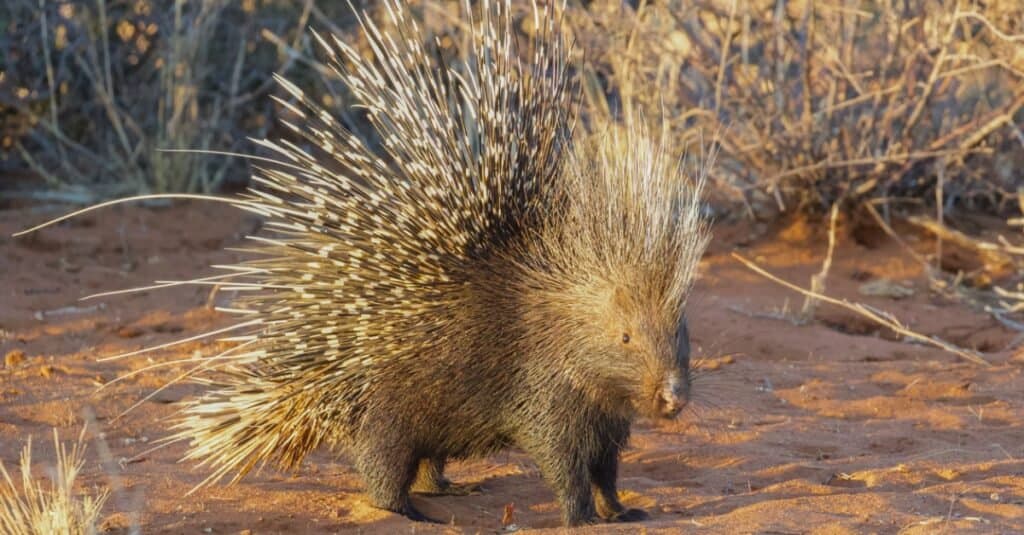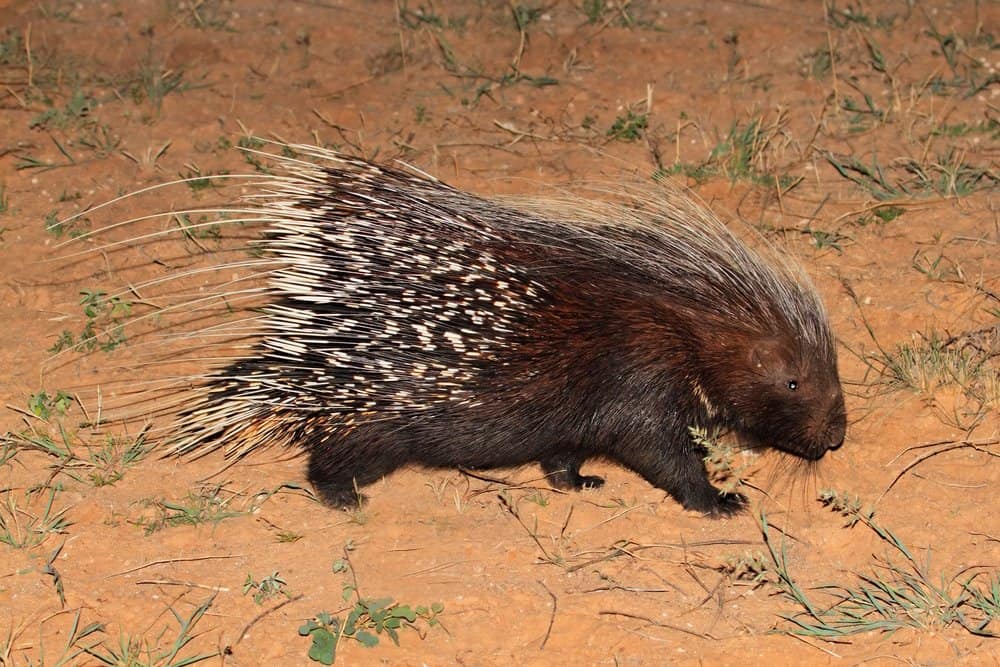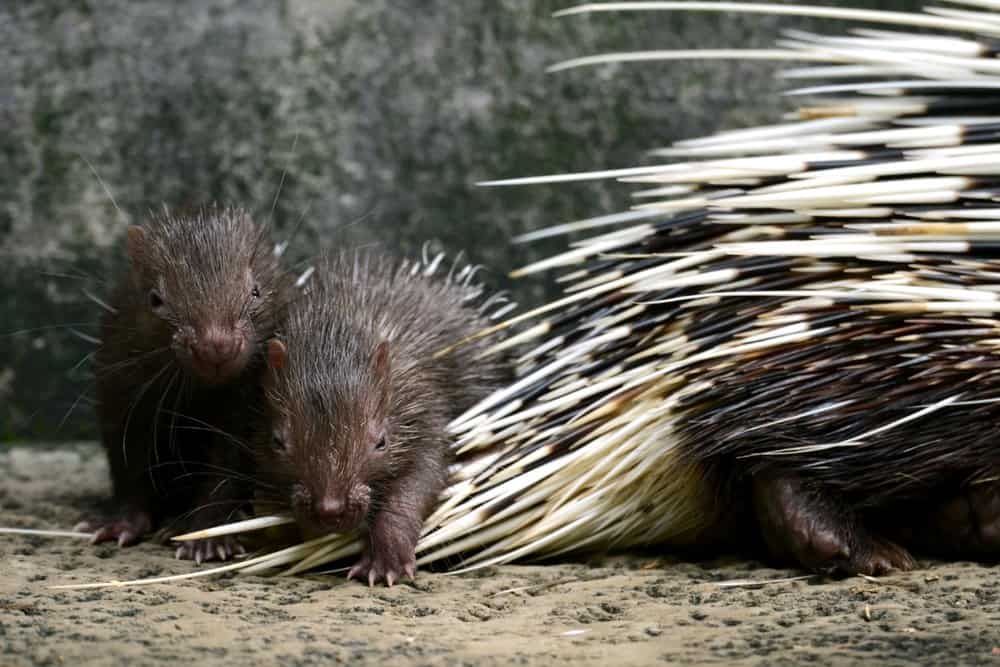North American porcupines look adorable and plump as they waddle, squeak and grunt. Their needle-sharp quills are their ultimate defense mechanism and can injure whatever and whoever is in their path.
These large rodents occupy many Texas regions and continue to expand their reach across the state. Find out where porcupines in Texas live, including how many are in the state and what problems they cause.
About Porcupines in Texas

Porcupines are among the largest rodents in the world.
©iStock.com/Pedro Ferreira do Amaral
Porcupines are among the largest rodents in the world, and the New World species are indigenous to North America and Northern South America. They are large, round, and slow, and their coloration consists of brown, gray, and white shades. Their spiny defense mechanism resembles a hedgehog’s and comprises more than 30,000 barbed quills, which are keratin “hair.”
Porcupines are expert tree climbers, but they move incredibly slow and awkwardly, always methodical with their foot placements and aware of their physical limitations. For such cumbersome creatures, they are just at home in trees in rocks as they are on flat ground. Enormous, broken rocks are their preferred spots for resting places, using caves and crevices as their dens. But they may also take to hollow trees and upturned root systems for cover and habitation. They rarely leave the immediate zone around their homes during winter, but warmer months allow their comfortable travel.
They breed in late summer to early fall, and their peak activity is in September and early October. Females typically give birth to one pup seven months later, in April or May. Their young are relatively independent shortly after birth but grow slower than other rodents.
What Do Texas Porcupines Eat?
These herbivores get 85% of their food from herbaceous ground vegetation, except in the fall when that number drops to 27%. In winter, most of their food is from trees, including pine needles, mistletoe, and inner bark. You can often see them climbing trees in search of bark when the weather is cold.
During spring, porcupines return to their herbaceous diet of leaves, herbs, twigs, and green plants. These rodents carefully browse their food selections, choosing what interests them, and are especially fond of salt.
Where Do Porcupines Live in Texas?

Porcupines occupy the entire Western half of Texas, including the Panhandle.
Porcupines in Texas occupy almost the entire western portion of the state, including the Texas Panhandle. These creatures have been recorded as far east as Van Zandt County and as far south as Hidalgo. Texas porcupines like the forested areas with rocks, ridges, and slopes of West Texas but can adapt quickly to various habitats. But you aren’t likely to see them in flats and valleys.
In the Llano Estacado, porcupines inhabit the long cliffs and short-grass prairies in Northwest Texas. You can also find them in Edward’s Plateau, along streams and rivers near brushy habitats. Porcupines continue to expand their reach into South and Central Texas.
How Many Are in the State?
During the nineteenth century, porcupines only occupied one county in the Texas Panhandle and two counties in West Texas. But they began expanding their reach in the twentieth century, and today you can find them in a large portion of the state. It’s unknown exactly how many porcupines live in Texas, but their conservation status is listed as “least concern,” meaning they are thriving in their wild habitats.
Do Porcupines Cause Problems?

Porcupines cause property damage and inflict injury on pets and farm animals.
©EcoPrint/Shutterstock.com
In Texas, porcupines are seen as problematic. Their herbaceous diet brings them to orchards, landscapes, and ornamental trees, where they can inflict significant damage. People often complain about how these pests can cause property damage as they eat their way through wood.
Porcupines can also injure wildlife and pets, like dogs, cats, cattle, and horses. When these creatures sense danger, they lift their quills and waggle their tail from side to side. If the warning signal is ignored, they will flip around, showing their backside, and begin thrashing as they advance in a backward position. Contrary to what some believe, porcupines don’t shoot their quills at enemies. Instead, some of their older barbs about to shed will come off and lodge in something or someone. However, this action is entirely accidental.
Are Porcupines Dangerous?

Porcupine quills are sharper than a hypodermic needle.
©dangdumrong/Shutterstock.com
Their quills are incredibly sharp, piercing the skin more effortlessly than a hypodermic needle. They feature overlapping, backward-pointing barbs that flare when encompassed inside warm flesh, making them difficult to take out. Once a barb is in the skin, muscle contractions cause it to move deeper into muscle and tissue. Many animals suffer fatal injuries when quills pierce their vital organs, some even becoming blind or unable to eat.
These sharp needles begin moving inward shortly after injection. There are many home remedies on the internet about removing them, some stating you should cut the tip and soak them in vinegar, while others suggest using a twisting motion to pull them out. Medical professionals agree that the best way to get porcupine quills out of the skin is to use a quick jerk. If you wait too long, the needle can become so deep you may need pliers to get a decent grip.
In some instances, the quill was so deep that people waited 48 hours for it to emerge from the skin as it slowly passed through muscle tissue. Don’t hesitate to seek medical care if you cannot remove a porcupine quill, especially if there is a chance it is near a vital organ or another sensitive area.
Up Next:
The photo featured at the top of this post is © iStock.com/photomaru
Thank you for reading! Have some feedback for us? Contact the AZ Animals editorial team.






